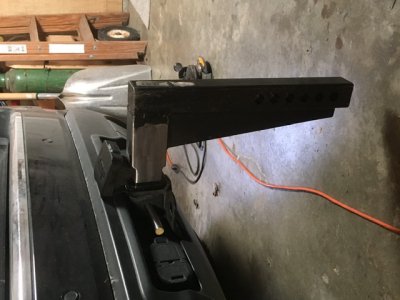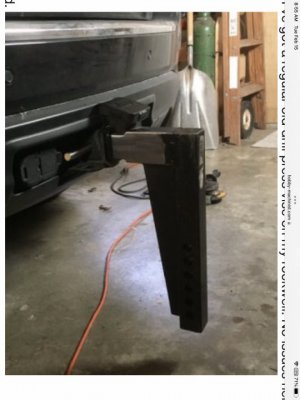This vise came with my Rockwell Mill and I'm finally getting around to getting it as parallel as I can. I got the head trammed on the only axis that it can be trammed. I then put the vise on the table and checked it with a test indicator. One end is less than .0005 from the other but all in all its super rough in between and along the tops and sides. I know I could buy some other steel stock and have it ground and hardened but I think I'd just get a small Glacern or something at that point. Hopefully this is in the correct area. I did some searching and reading too but I thought I'd see if anyone had some more specific ideas as far as my situation goes. Here's a picture of the jaws as well as my indicator running across it.
-
Welcome back Guest! Did you know you can mentor other members here at H-M? If not, please check out our Relaunch of Hobby Machinist Mentoring Program!
You are using an out of date browser. It may not display this or other websites correctly.
You should upgrade or use an alternative browser.
You should upgrade or use an alternative browser.
Clausing Mill Vise Jaws - what to do?
- Thread starter JRT
- Start date
If the jaws are parallel and rough, take and sand them and lap them on a flat surface. Use glass if you don't have a good flat area. If the jaws are crooked, machine them as Larry$ said above. The jaws only need to be "flat" You don't want ridges sticking out from the faces. Minor dings and depressions on the other hand don't make a difference as your material will span across them.
- Joined
- Nov 25, 2015
- Messages
- 9,631
I cannot make out this pic. What am I looking at?What's the problem? Cosmetic? Use it. I've got a regular old drill press vise on my rockwell. No issues here. Machined one side of 12" drop hitch on it this weekend. View attachment 396509
I guess it's technically not a problem, I have been using it and for larger pieces it's not really an issue. I just want to get it all straight since I've been cleaning years of build up off of it recently Also, I'm just super meticulous so I would like it to be square.What's the problem? Cosmetic? Use it. I've got a regular old drill press vise on my rockwell. No issues here. Machined one side of 12" drop hitch on it this weekend. View attachment 396509
TTake the jaws off and set them on parallels back in the vice. Take a skim-cut with a carbide shell mill, reinstall.
Larry, this is a great idea! I don't have a shell mill as I'm relatively new to this and I currently only have the end mills and horizontal cutters that the previous owner of my mill gave me. I'm going to research these now. Any specific recommendations?Take the jaws off and set them on parallels back in the vice. Take a skim-cut with a carbide shell mill, reinstall.
Thank you also Chewy, this is helpful as well, however there have been some pretty bad "mishaps" on these faces and sanding them wont take them down far enough without doing it for a few days probably. Also, I do smaller parts so if the work piece lands in the middle somewhere between the two ends I think I run the chances of non-squareness.If the jaws are parallel and rough, take and sand them and lap them on a flat surface. Use glass if you don't have a good flat area. If the jaws are crooked, machine them as Larry$ said above. The jaws only need to be "flat" You don't want ridges sticking out from the faces. Minor dings and depressions on the other hand don't make a difference as your material will span across them.
- Joined
- Dec 20, 2012
- Messages
- 9,422
Seems to me that you have several options:
- Remove the jaws and have them surface ground.
- Make new jaws.
- Buy a decent vise. My personal view is that the milling vise holds 90+% of the work the mill does so having something that isn't accurate is self-defeating.
- Joined
- Nov 25, 2015
- Messages
- 9,631
My view is a little different. My view is to make this work for you, until the time you feel an upgrade is necessary.
We all make lots of mistakes, better to work and learn on a vise that is not NEW and learn. Make due until the time you feel you are a competent machinist not going to make beginner mistakes. I don't know your level, but I am of the opinion that unless the vise is holding you back fix what you have. 2 ways to do it with what you have already have been presented.
1) mill it.. you really don't need a shell mill, a regular end mill will do it, albeit in multiple passes. After you are done, sand it to clean up as much as possible.
2) sand it, a little more laborious, but doable. you would only be getting high spots out.
3) use a stone to remove high spots
4) have someone local to you surface grind them.
5) make a set of soft jaws and use them.
We all make lots of mistakes, better to work and learn on a vise that is not NEW and learn. Make due until the time you feel you are a competent machinist not going to make beginner mistakes. I don't know your level, but I am of the opinion that unless the vise is holding you back fix what you have. 2 ways to do it with what you have already have been presented.
1) mill it.. you really don't need a shell mill, a regular end mill will do it, albeit in multiple passes. After you are done, sand it to clean up as much as possible.
2) sand it, a little more laborious, but doable. you would only be getting high spots out.
3) use a stone to remove high spots
4) have someone local to you surface grind them.
5) make a set of soft jaws and use them.



